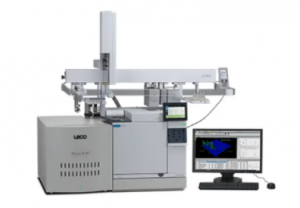LECO Pegasus® BT 4D GCxGC-TOFMS – A Review of Our Initial Work
LECO Pegasus® BT 4D GCxGC-TOFMS – A Review of Our Initial Work. J. Dunscombe, Anatune, Senior Applications Chemist
LECO Pegasus® BT 4D GCxGC-TOFMS
Before my role at Anatune, if you had asked me about my opinion on GCxGC multi-dimensional chromatography or time-of-flight mass spectrometry (TOF-MS), you would not have had much of a response. To me, these were the sorts of techniques that were reserved for research purposes only.
However, since joining Anatune I have had the privilege to get to try all sorts of analysis techniques. None has been more interesting than two-dimensional chromatography (2D GC or GCxGC as it can also be known). Even more so when coupled to TOF-MS instrumentation.
Since 2021, Anatune has been working with LECO, who are experts in the field of GCxGC. It is from this partnership I have had the opportunity to work on LECO’s Pegasus BT 4D instrument – a GCxGC capable with sub-nominal mass TOF-MS.
For those who are not familiar, GCxGC is an orthogonal separation technique utilising two GC columns with entirely different stationary phases to maximise the separation space. For example, a DB-5 (5% phenyl) and WAX (polyethylene glycol) pairing separates non-polar and polar compounds alike. A DB-1 (silyl methyl groups) and DB-17 (50% phenyl) provides separation of both alkyl and aryl compounds. The latter being exceptionally useful for total petroleum hydrocarbon analysis where it is necessary to fully separate the alkyl and aromatic hydrocarbons.
As a chromatographer, this is the exciting part and demonstrates very well the chemistry that should be thought of when developing a GC method.
The example below shows the comparison of contour plots of an injection of a custom mix containing many compound types: linear alkane chains, aromatics, and polar-reactive groups on DB-5/DB-35 (figure 1) and DB-5/RTX-200 pairings (figure 2).

Figure 1. DB-5/DB-35 pair

Figure 2. DB-5/RTX-200 pair
It is easy to spot that, whilst using a DB-5/DB-35 pairing, there is a much greater separation in the second dimension when compared to DB-5/RTX-200 for the aromatic compounds (figure 3).
The compounds involved here have lots of aromaticity and so it makes sense that columns with a high percentage of aromatic chains would provide greatest separation for my work. Not only was this a simple and exciting chromatography demonstration, with LECO’s ChromaTOF software, development of GCxGC methods is exceptionally simple and can be done with one click of a button, something which is great for me as a relative novice to this technique.
Two-dimensional chromatography should not be discussed without reference to the detector used, in this case the Pegasus BT. A sub-nominal mass time-of-flight (TOF) detector. TOF instruments have the advantage that as they do not have quadrupoles that need to ‘scan’ a mass range, acquisition rates can be very, very fast.
This is a huge benefit for GCxGC where peak widths are fractions of a second wide and so to maintain adequate points across a peak, acquisition rates need to be exceptionally fast. LECO’s Pegasus BT instrument can acquire spectra 200 times per second, something beyond the ability of quadrupole mass spectrometers.


Figure 3. Column separation comparison. A much greater spread of the analytes is observed with a DB-5/DB-35 pairing highlighting the greater separating power with this column coupling
As a novice to these techniques, not only has it been interesting to see fundamental separation science in action. It has also been relatively easy to develop the methods I want – something which initially seemed daunting to me when thinking about 2D GC development. Method development is made even easier with the Simply GCxGC tool. Again, a big tick in my book. When I think of this instrument coupled to a GERSTEL MultiPurposeSampler, I have a very powerful tool at my disposal that can meet the majority of my routine and developmental needs.
If you have an application which you think may benefit from GCxGC, then get in touch to see just what the LECO Pegasus BT 4D can do for you.
CLICK HERE to view our range of LECO instrumentation, or CONTACT US to find out more about and our wide range of GC, GCxGC, and GC-MS work.
About the Author:

Jonathan Dunscombe, Anatune, Senior Applications Chemist
“Starting my career, I gained a Chemistry Degree at University of Cardiff before training as a science teacher. Shortly after, realising that industry was for me, I took up position as a lab technician with Severn Trent Services.
Staying for six years, I gained experience in multiple techniques and analyses across multiple chemistry based disciplines. I also managed a team for two years; learning what it takes to manage a functioning team coping with high throughput and short turnaround times.
During this time I gained experience using different GERSTEL MPS equipment; notably a dual rail headspace system and dual head ITSP solution. My strengths lay within the water industry and it is this experience that I bring to the Anatune team.
I joined in January 2017 as an Applications Chemist. Before this I had many dealings with the Anatune team; this is where I experienced first-hand how experienced and enthusiastic the team are. Being able to work with people spanning multiple industries is very exciting which also expands your knowledge of other disciplines.”
Previous post
Syft Technologies User Day 2022Next post
PRODUCT FOCUS: Agilent 8890 GC System

